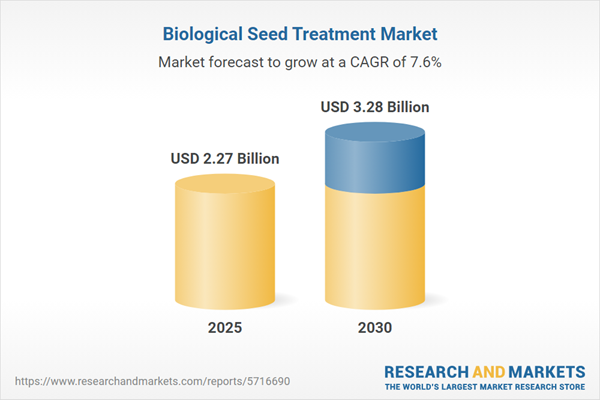The biological seed treatment market, valued at US$2.27 billion in 2025, is projected to grow at a CAGR of 7.58% to reach US$3.28 billion in 2030.
Biological seed treatments use renewable resources and include naturally occurring active compounds that protect against pathogens that are transferred by the soil, reduce abiotic stress, and promote plant growth. Over the projected timeframe, the market is anticipated to rise due to the surge in demand for crops grown without chemicals. This demand is further fueled by a change in consumer preferences toward enhancing individual health and consuming nutritious food. The market for biological seed treatment is steadily growing, and new technology is required to allow yield-protecting, environment-friendly solutions that maximize farmers' returns on investment.
Biological seed treatments use renewable resources and include naturally occurring active compounds that protect against pathogens that are transferred by the soil, reduce abiotic stress, and promote plant growth. Over the projected timeframe, the market is anticipated to rise due to the surge in demand for crops grown without chemicals. This demand is further fueled by a change in consumer preferences toward enhancing individual health and consuming nutritious food. The market for biological seed treatment is steadily growing, and new technology is required to allow yield-protecting, environment-friendly solutions that maximize farmers' returns on investment.
Market Trends:
- Organic Farming: Organic farming has seen remarkable growth worldwide. Rising incomes, a surge in health-conscious consumers, and improved farming techniques that enhance organic crop yields are key factors fueling the soaring demand for organic products. As a result, the global appetite for organic food has significantly boosted organic farming regions across the planet.
- Use of Bio-Priming Techniques: Bio-priming stands out as an affordable, straightforward, and eco-friendly method to integrate beneficial microorganisms into agricultural systems. Crops grown using bio-priming technology benefit from better germination rates, improved water efficiency, reduced environmental harm, protection against plant diseases, and enhanced nutritional value.
- Investment in Biological Seed Treatments: Companies are actively investing to boost their profits by developing advanced solutions and reliable outcomes for the growing global biological seed treatment market. For example, Rizobacter, an Argentine company, allocated $4 million to expand its operations, modernize infrastructure, and adopt new technologies to strengthen its foothold in the biological seed treatment sector. The firm is broadening its reach into Europe, Asia, Africa, and North America while reinforcing its dominance in Latin America, capitalizing on the increasing global demand for organic products to advance agricultural practices.
- North America: The biological seed treatment market in North America is on the rise, driven by the need for effective crop protection, especially against evolving pests and disease challenges. This focus is a significant catalyst for market growth. Additionally, the U.S. is witnessing a growing shift toward sustainable surfactants and an expanding market for bio-based products.
Key Benefits of this Report:
- Insightful Analysis: Gain detailed market insights covering major as well as emerging geographical regions, focusing on customer segments, government policies and socio-economic factors, consumer preferences, industry verticals, and other sub-segments.
- Competitive Landscape: Understand the strategic maneuvers employed by key players globally to understand possible market penetration with the correct strategy.
- Market Drivers & Future Trends: Explore the dynamic factors and pivotal market trends and how they will shape future market developments.
- Actionable Recommendations: Utilize the insights to exercise strategic decisions to uncover new business streams and revenues in a dynamic environment.
- Caters to a Wide Audience: Beneficial and cost-effective for startups, research institutions, consultants, SMEs, and large enterprises.
What can businesses use this report for?
Industry and Market Insights, Opportunity Assessment, Product Demand Forecasting, Market Entry Strategy, Geographical Expansion, Capital Investment Decisions, Regulatory Framework & Implications, New Product Development, Competitive Intelligence.Report Coverage:
- Historical data from 2022 to 2024 & forecast data from 2025 to 2030
- Growth Opportunities, Challenges, Supply Chain Outlook, Regulatory Framework, and Trend Analysis
- Competitive Positioning, Strategies, and Market Share Analysis
- Revenue Growth and Forecast Assessment of segments and regions including countries
- Company Profiling (Strategies, Products, Financial Information, and Key Developments among others)
Biological Seed Treatment Market Segmentation:
By Type
- Microbials
- Botanicals
By Crop
- Corn
- Wheat
- Soybean
- Cotton
- Vegetable Crops
- Others
By Function
- Seed Protection
- Seed Enhancement
By Region
- North America
- Europe
- Asia Pacific
- South America
- Middle East & Africa
Table of Contents
1. EXECUTIVE SUMMARY4. TECHNOLOGICAL OUTLOOK
2. MARKET SNAPSHOT
3. BUSINESS LANDSCAPE
5. BIOLOGICAL SEED TREATMENT MARKET BY TYPE
6. BIOLOGICAL SEED TREATMENT MARKET BY CROP
7. BIOLOGICAL SEED TREATMENT MARKET BY FUNCTION
8. BIOLOGICAL SEED TREATMENT MARKET BY GEOGRAPHY
9. COMPETITIVE ENVIRONMENT AND ANALYSIS
10. COMPANY PROFILES
11. APPENDIX
Companies Mentioned
- BASF
- Bayer AG
- Syngenta
- Koppert
- Incotec
- Plant Health Care
- Bioworks, Inc.
- Verdesian Life Sciences
- Corteva, Inc.
- Albaugh, LLC
Methodology

LOADING...
Table Information
| Report Attribute | Details |
|---|---|
| No. of Pages | 155 |
| Published | March 2025 |
| Forecast Period | 2025 - 2030 |
| Estimated Market Value ( USD | $ 2.27 Billion |
| Forecasted Market Value ( USD | $ 3.28 Billion |
| Compound Annual Growth Rate | 7.5% |
| Regions Covered | Global |
| No. of Companies Mentioned | 10 |









